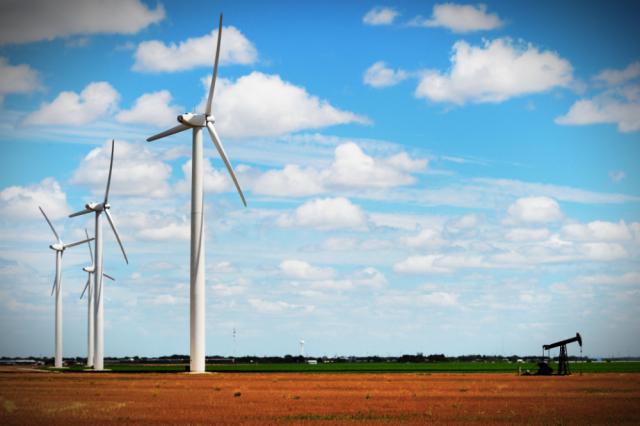
The green versus fossil reversal of fortune might not last. Or the political economy of energy would have to change much more dramatically than we have seen so far. (Source: Image of wind turbines next to pumpjack in West Texas by Shutterstock.com)
[Editor’s note: Opinions expressed by the author are their own.]
So we have a consensus that there has to be a global transition to net-zero carbon emissions by 2050, if not sooner. Supranational bodies, national governments, major corporations, NGOs and financial institutions have their differences in timing or the mix of solutions.
But particularly with the departure of the Trump administration, we largely agree on the requirement to shift away from fossil fuel.
So why have fossil fuel equities prices, broadly, been rising since the beginning of the year, and why are many clean energy equities performing weakly, or even declining in price?
Let’s take a few examples. The ICLN i-Shares Global Clean Energy ETF is down by 14% since the beginning of 2021. TAN, Invesco’s solar ETF, has declined by 10.7% from the start of trading in January. On the other side, XLE, an ETF representing major oil companies, has risen 29.4% in the year to date.
As for individual companies’ share prices, we have Ørsted, the Danish wind energy developer, down by 24% in 2021. Vestas Wind Systems, its compatriot company, which designs and manufactures wind turbine systems, has seen its shares fall 15.7% since the start of the year.
Vestas’ competitor in the wind turbine space, Siemens Gamesa Renewable Energy, has enjoyed a bit of a bump in investor interest lately, but its equity is still down 0.3% this year.
RELATED:
From Oil and Gas Investor Editor-in-Chief: Green Shoots for Black Gold
On the other side of the virtue divide we have the U.S. fracking-oriented exploration and production companies. Consider EOG Resources Inc. It is the reincarnation of Enron Oil and Gas, which was probably the most carbon-intensive part of the Enron, the scandal magnet energy giant bankrupted in 2001.
These days, though, EOG has an A-minus bond rating and a reputation for having one of the most skillful E&P management groups. Its shares have risen by 45.4% since the beginning of 2021.
Or consider Cabot Oil and Gas Corp. of Houston. It has concentrated on drilling the gas-rich Marcellus Shale basin in the Eastern U.S. and has seen its share price go up by 15.4%.
Of all the oil majors, Exxon Mobil Corp. might be considered the least likely to have put solar panels or wind turbines in green meadows on the cover of the annual report. And yes, its share price is up 35.4% since the start of the year.
This is all so strange. BlackRock just wrote to its clients about “Net Zero, a fiduciary approach.” In that note, it told us that “In 2020 we completed our goal of having 100% of our active and advisory portfolios ESG-integrated.”
If that really represents “best practices” for investment managers, why are previous high returns for clean energy companies not being continued in 2021? Reasons might include overcrowded auctions for clean energy development rights and green-power contracts, rising interest rates and OPEC oil supply cuts.
I believe all of those conditions are reflected in the share prices. There has been a lot of capital thrown at clean energy development in recent years, at least relative to portfolio investors’ interest in fossil fuels.
This was reflected in the recent auction for seabed sites for offshore wind by the U.K.’s Crown Estates. These went for 10 times to 20 times the prices paid at the last such auction in 2010. As the investment company Bernstein wrote in March, the results are “feeding already existing market worries about overheating competition in offshore wind and pressures on returns.”
And that is before the wind projects are built. The prices and terms for clean energy generation are becoming less favourable as more developers bid against each other for power offtake contracts. In places such as California, consumers’ rooftop solar power has sharply cut the peak load commercial developers (and their lenders) were counting on to pay the bills.
Meanwhile, the remaining shale E&P companies have survived past price declines and debt service burdens. As a group, they no longer spend every dollar of earned or borrowed cash to drill more wells. OPEC is still producing oil below its collective capacity.
The green versus fossil reversal of fortune might not last. Or the political economy of energy would have to change much more dramatically than we have seen so far.
Recommended Reading
E&P Highlights: Jan. 29, 2024
2024-01-29 - Here’s a roundup of the latest E&P headlines, including activity at the Ichthys Field offshore Australia and new contract awards.
Seadrill Awarded $97.5 Million in Drillship Contracts
2024-01-30 - Seadrill will also resume management services for its West Auriga drillship earlier than anticipated.
Oceaneering Won $200MM in Manufactured Products Contracts in Q4 2023
2024-02-05 - The revenues from Oceaneering International’s manufactured products contracts range in value from less than $10 million to greater than $100 million.
E&P Highlights: Feb. 5, 2024
2024-02-05 - Here’s a roundup of the latest E&P headlines, including an update on Enauta’s Atlanta Phase 1 project.
CNOOC’s Suizhong 36-1/Luda 5-2 Starts Production Offshore China
2024-02-05 - CNOOC plans 118 development wells in the shallow water project in the Bohai Sea — the largest secondary development and adjustment project offshore China.





